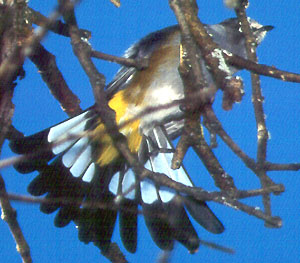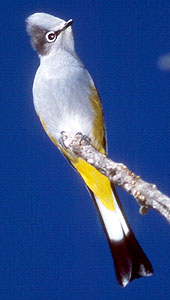 but on Monday it chased around several Phainopeplas and was seen with a couple
of Townsend's Solitaires.
but on Monday it chased around several Phainopeplas and was seen with a couple
of Townsend's Solitaires.Gray Silky-flycatcher
Blue Jay Campground, Cleveland National Forest, Orange County
4.5 miles north of El Cariso Village, 31 January - 6 February 1999
Joseph Morlan
 by Larry Sansone
© 1999
by Larry Sansone
© 1999
On Sunday,31 January 1999, Robbie Fischer and I decided to join Dan Lockshaw in search of the Gray Silky-flycatcher which Dan and his wife had seen for the last two days, 29-30 January 1999 in the Santa Ana Mountains of eastern Orange County. We arrived about 8:30am to be greeted by mist and rain. Joel Weintraub was already there and he soon spotted the Gray Silky-flycatcher high in a dead snag near the parking area which is on the right at a sharp bend just before the Falcon Group Camp. Dan got his new KOWA TSN821 scope on the bird while we attempted to shelter the lens with an umbrella and we all got decent views of the bird.
On Monday, February 1st, I decided to go back in better weather to study the bird in more detail. I was particularly
interested in assessing the extent of wear on the tail. I arrived about 8:30am and remained until 3:30pm studying
the bird closely through my KOWA TSN4. During the day the bird was enjoyed by numerous observers including Tom
Bishop, Howard King, John and Irma Levine, Vernon Howe, Al Eisner, etc. and photographed by Larry Sansone and Gary
Meredith. On Sunday the bird associated mostly with Western Bluebirds,  but on Monday it chased around several Phainopeplas and was seen with a couple
of Townsend's Solitaires.
but on Monday it chased around several Phainopeplas and was seen with a couple
of Townsend's Solitaires.
On Saturday, February 6th, Robbie and I headed back to look at the bird some more. The weather was warmer and the bird more cooperative, often sitting perched in the open on the dead snags and chasing off the Phainopeplas. The Gray Silky-flycatcher was very territorial in defending the large clumps of Mistletoe.
The following is a composite based on notes taken during the three days:
The bird seemed slimmer than adjacent Western Bluebirds. It was about the size and shape of adjacent Phainopeplas but but decidedly longer tailed. It was overall gray in coloration with a rather short pointed crest and it had no wing-bars.
The forehead, supraloral area, mustachial area and chin were paler, almost white blending with the blue-gray coloration of the rest of the bird. Faint dusky malar stripes separated the paler chin from the pale mustachial area. A very subtle faint gray streaking was visible on the throat at certain angles.
The tertials and primaries were blackish, contrasting with the gray edges to the secondaries, and wing coverts. The outermost tertial had a faint gray outer web and the outermost greater coverts were narrowly tipped with black forming a faint black wing-bar. Three dark primaries were visible past the folded secondaries. The tertials formed dark triangular patches on either side of the back. The scapulars were tipped with whitish. While preening the underside of the wing showed white underwing coverts and some white was visible on the inner webs of the innermost secondaries. Only three rather rounded primaries were visible beyond the folded tertials. The wing tip did not reach past the uppertail coverts. Thus the wing was rather rounded and relatively short. On Saturday, I noticed the innermost visible primary was contrasting brown in color, suggesting a molt limit.
As the bird preened, its tail showed the pattern of the individual feathers. The feathers were black, but all except the central pair had long squarish white spots on the inner webs extending about half way from the base toward the black tip. These white spots were visible on the upperside of the tail when the tail was fanned. From below they appeared as a white base to the otherwise black tail. The white was narrowly bordered in black when seen from below. The overall effect reminded me of the tail pattern on a Magnolia Warbler. On Sunday I thought the tip of the tail appeared worn, but Dan Lockshaw felt that was an artifact of the wet feathers and that the tail tip had appeared clean when he observed the bird in good weather the previous days. On Monday, in dry weather the tip of the tail looked much better, but still showed slightly frayed tips on the outer left rectrices. The central rectrices and outermost right rectrix appeared fresh. These feathers were all highly asymmetric, narrow on the outer web and strongly curved on the inner web, resulting in a slightly notched appearing tail tip caused by the shape of the individual feathers. A small notch was visible on the inner corner of the tip of the left rectrix. Overall, the tail was almost as long as the body and splayed out at the tip, narrower at the base. From above, the black tail showed even growth bars, appearing as straight ripples across the tail.
The long undertail coverts were bright yellow, contrasting strongly with the long slim black tail. A narrow black line bisected the tips of the yellow undertail coverts. The underparts were blue-gray with burnt-yellow suffused with gray on the flanks and sides contrasting with a paler whitish belly. The yellow undertail showed a slightly brighter orange cast toward the flank.
The dark eye showed a hint of red-amber in bright sunlight. The eye was accented by a nearly complete circular white eye-ring, broken imperceptibly in front. The dark lores contrasted with the otherwise gray face. The ear coverts were darker than the rest of the bird and showed a slight vinaceous cast.
The black bill was short and stubby, very broad at the base. The nostrils were wedge-shaped with feathering to the base of each nostril. Whitish rictal bristles were visible on the underside and short black bristles were in the loral region.
The legs and feet were dark gray. Parallel plates (scutes)were visible across the front of the legs down through the toes.
On Sunday, the bird flew about in the remote mixed pine-oak woodland, associating closely with a flock of Western Bluebirds, but on Monday it spent the entire day in a single oak tree which was heavily festooned with fruiting mistletoe. I watched it eat these white berries in great number. During feeding, it kept its crest flat, but while perched on dead snags it usually raised it, especially while vocalizing.
In flight, it gave a musical two-note whistled call, reminding me of the call of Phainopepla, but higher and thinner. On Monday, it perched on dead branches and sang a faint very long rather complex thrasher-like song. This song included low throaty "chuck" notes as well as very high "seep" notes. At times it gave a number of high musical calls, usually slightly doubled and slurred up then down.
On Sunday, Joel Weintraub took a few poor but recognizable digital photos of the bird in the rain. Dan Lockshaw showed me a short, very poor video clip of the bird taken the previous day, but I understand he now has much better footage. Soon Kaaren Perry and Maya Decker arrived, but the rain was getting very heavy and the bird had disappeared. They saw the bird after we left. On Monday, the bird was well photographed by Larry Sansone, Gary Meredith and others and seen well by many interested observers.
I think the identification is well established. As in past occurrences of this species in California, the question will center on whether the bird was wild or an escaped cage-bird. The California Bird Records Committee has reached the following decisions in the past:
GRAY SILKY-FLYCATCHER Ptilogonys cinereus (2,0,2,0) Not Accepted, identification not established 4 Jun 1983 Pt. Loma SD 146-1993-18 Not Accepted, natural occurrence questionable 9 Apr 1976 Ventura VEN 115-1980-7 (ph.) 24 May 1993 Pt. Loma SD 115-1993-18 10-12 Mar 1994 Poway SD 75-1994-20 (ph.)
The species is generally non-migratory although some downslope movement has been noted during the winter in Mexico. Previous California records have been primarily in coastal lowlands close to heavily populated areas. I agree that the natural occurrence of such records may be questionable.
The Texas Bird Records Committee has accepted two records of this species including one in January-March 1995 in El Paso. Their 1996 Annual Report speculated that "a drought and crop failure in the species native range may have contributed to the bird's appearance." Likewise major drought and wildfires spread across Mexico February-May 1998 which might have contributed to dispersal of this species last year. The species was added to the ABA Checklist based on a Fall 1985 record at Laguna Atascosa, Texas (Birding 18:34-36, 1986; Birding 23:190-196, 1991).
Although this species is apparently kept in captivity in Mexico, I believe that the Orange County record, in remote highland pine-oak woodland at an elevation of about three thousand feet during the same season as the accepted El Paso record is more likely to have been a genuinely wild bird than the previous lowland, urban records. As with all such cases, we will never know for sure, but the habitat seems like a reasonable match to that in the species' native range.
On Monday, I assessed the extent of feather wear on the tail, finding the tips of the outer rectrices somewhat frayed on the left side only. On Saturday, a small amount of wear was visible on the right side as well. Other rectrices appeared fresh. All other feathers, including body and wing feathers appeared clean and fresh. The toes and feet appeared in excellent condition without any unusual toenail growth or other abnormalities which are common on recently escaped cage birds. The legs were seen clearly and no bands were present. I could find no other evidence that the bird had been kept in captivity.
Lasley, G.W. & T. Pincelli. 1986. Gray Silky-Flycatcher in Texas: Finally an ABA-area Accepted Record? Birding 18:34-36.
DeBenedictis, P. 1991. ABA Checklist Report, 1990. Birding 23:190-196.